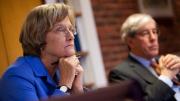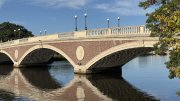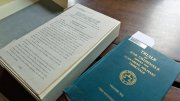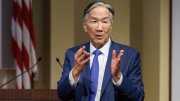The Harvard Corporation’s self-review of its operations and organization--begun in 2009 and first disclosed to the community that December 15 by President Drew Faust--has culminated in a series of measures to modernize and, in part, refocus the work of the University’s senior governing board (formally, the President and Fellows of Harvard College). The changes, discussed with the Board of Overseers during the review and then aired and adopted jointly in a series of votes on December 4, are outlined in a five-page “Report to the University Community” by the Harvard Corporation Governance Review Committee, released on December 6.
• Membership on the Corporation will increase from the University’s president and treasurer plus five Fellows (as constituted ever since the Charter of 1650), to a 13-member group (the president and 12 others, including the treasurer). The appointments required to fill out the new membership are expected to be made within the next two to three years.
It has been long assumed that any such change in governance would require approval by the Massachusetts legislature. But according to Senior Fellow Robert D. Reischauer ’63, “We have reviewed the matter thoroughly, both internally and with outside counsel, and have determined that the University has full authority to make the changes voted this weekend by the governing boards. Harvard has also conferred with the Office of the Attorney General for the Commonwealth of Massachusetts, which saw no reason why the University could not exercise its authority to adopt these changes.”
• Term limits. There will be a presumption of terms of service (“[W]e envision that ordinarily members will serve for six years, with the prospect of their service being extended for up to six years”).
This is a modification of open-ended appointments and of the informal recent practice that Corporation members have tended to step down after a decade or so, or at or about age 70. (Although the report does not say so, the enlarged membership, the expectation of limited terms, and some specialization--see below--may in combination make Corporation service feasible for a broader range of candidates, at different stages of their careers.)
• Formal, substantive committees. The newly enlarged Corporation will form standing, substantive committees (as opposed to acting almost exclusively as a committee of the whole), including: a Committee on Finance; a Committee on Facilities and Capital Planning; and a Committee on Governance, chaired by the Senior Fellow, to address “matters of trusteeship,” ensure a smooth flow of work between and among the Corporation and its committees, and assure “periodic future assessments of the Corporation’s operations.”
Significantly, the first two committees will consist “principally” of Corporation members, but each “may also enlist the service of others with especially helpful professional expertise, drawn from among accomplished alumni, including current or former Overseers, and others.”
• Alumni affairs and development. With the Overseers, the Corporation will form a new Joint Committee on Alumni Affairs and Development. (It will exist alongside three already existing joint committees: on Inspection, which is the audit and risk-management committee; on Appointments; and, in an advisory capacity, on Honorary Degrees.)
As to practices, the report outlines several subtle, but significant, reforms.
• A lead trustee. The Senior Fellow will act as “a lead player within the board,” who will be “expected to take a more active part in framing Corporation agendas and setting priorities for its work,” a role that has heretofore been the president’s (as discussed in a Harvard Magazine roundtable, “Governing Harvard” May-June 2006, page 25). The Senior Fellow will, moreover, be chosen for the role by fellow Corporation members, rather than merely inheriting it through longevity; and will chair the new governance committee.
• Outreach and communications. The Corporation and its members “will engage more with a broader range of University constituents, in both formal and informal settings”--an effort to improve its access to information and diverse views--and will through the president or Senior Fellow “report to the community at least four times” annually on its work.
• Strategic planning. In conducting its work, the Corporation will endeavor increasingly to “focus its attention on strategic priorities and plans, high-level policy matters, and core fiduciary concerns.” Among those identified are “ways in which the different parts of the University can not only flourish individually, but draw still greater strength from one another.”
In a December 5 conversation about the changes, Senior Fellow Reischauer characterized the Corporation-Overseers meeting of the prior day as “a historic gathering in many respects.” President Faust, who is an historian, amplified, noting that the participants were “exhilarated”--fully aware that on the verge of the University’s 375th anniversary (next year), they were modifying a set of procedures, put in place in the 1650 Charter, to better “situate us for the next 375 years.” Reischauer, a former Overseer, said that the package of reforms was but “one step among many that we’ve taken” in the past few years that will lead to a closer relationship between the two governing boards. In voting to enact the changes (the two boards had never before observed each other casting votes), the appointed Fellows and elected Overseers sensed they were “all part of doing something they wanted to do for the best interests of Harvard, together.”
Fundamental to the success of the review, Faust said, was focused consideration of the simple but difficult question: “What is the work of the Corporation?” As Harvard has changed, in a world itself changed by closer international connections, information technology, and other factors, that question drove much of the thinking about changes in organization and processes. “Once we began our self-examination,” Reischauer added, “the nature of the agendas at the Corporation meetings began to shift”--toward strategic considerations bearing on the University five and 10 years hence.
Faust said that Richard P. Chait, research professor of higher education at the Graduate School of Higher Education--an expert on higher-education governance and leadership who served as a counselor to the review committee (and was also a participant in this magazine’s 2006 roundtable)--had spoken memorably of boards’ role as a source of “insight” and “foresight,” as well as “oversight.” Reischauer said that establishing committees focused on some of the Corporation’s foremost fiduciary obligations--groups that could “drill deeper” into financial and capital-planning issues, and distill information and provide options to the other members--would enhance “immeasurably” the Fellows’ capacity to deal with strategic priorities and longer-term issues.
Overall, Faust said, the Corporation-Overseers discussion of the changes had resonated with “the spirit of consequentiality and possibility” for Harvard. Reischauer said the formal changes in governance were of a piece with enormous changes within the central administration in the past few years--“in the capacity of the center to do good for the rest of the University” in spheres ranging from information technology to capital planning to enhanced “rationality” in the budgeting process. All of those improvements, he said, were important to the University’s core educational, research, and academic mission. In this sense, Faust said, “Strengthening the Corporation strengthens the context in which to undertake those activities” at the heart of Harvard.
The Rationale for the Review
In its report, the Governance Review Committee (the Corporation members plus Frances D. Fergusson, Ph.D. ’73, president emerita of Vassar College and Overseers president in 2007-2008; Robert N. Shapiro ’72, J.D. ’78, a former president of the Harvard Alumni Association and now chair of the Overseers Committee on Institutional Policy; and Seth P. Waxman ’73, a former U.S. Solicitor General and current Overseers president) stressed the Corporation’s “principal fiduciary responsibility for Harvard’s institutional well-being” and noted that the review “focused on assuring its capacity to fulfill its role as effectively as possible.”
When she first broached the subject publicly, at a Faculty of Arts and Sciences meeting in December 2009, President Faust suggested that the review would encompass processes and procedures: the Corporation’s agendas and use of its meetings, its access to information and interaction with University constituencies, its relations with the central administration and the Board of Overseers, and its use of advice made available to it. In a conversation last September, she said the review would encompass what Corporation members and those with whom they consulted thought needed to be done in order to address “what the absences or omissions have been.”
The timing for the review was right, according to the report, as a matter of routine good practice; because the financial crisis had prompted all parts of the University to examine their roles and operations (and therefore, Faust said on December 5, it was fitting for the Corporation to model the same discipline itself); and because “the past decade has been a time of unusual challenge, growing complexity, and consequential change both for Harvard and for higher education at large.”
According to the report, changes in Corporation structure and operations are based on several premises.
• Capacity. The Corporation’s “collective capacity needs to be commensurate with the University’s scale, scope, and complexity”--suggesting that a body comprising the president, treasurer, and five Fellows is too small and too limited in expertise to fulfill its responsibilities relative to the twenty-first-century research university.
Note that the review did not recommend something wholly different. It concerned the Corporation, not Harvard governance or administration overall. The review did not call for a single, larger board of trustees superseding both the Corporation and the Board of Overseers, with or without elections for some or all of those trustees. Reischauer observed on December 5 that the dual board structure “is a strength of Harvard,” and has the potential to become even more so, given the boards’ different memberships, sizes (the Board of Overseers has 30 members, plus the president and treasurer), and skills.
Although the Corporation will grow, the “collegiality and the ability to have frank discussions” that characterize its operations will not be compromised, he said. In the meantime, the enlarged number of Fellows will “allow us to augment the Corporation with some specific skills and backgrounds and experiences that maybe we don’t have.”
• Fiduciary responsibilities, broadly defined. Given its statutory responsibility, and its self-understanding, as the University’s “principal fiduciary body” (as the new governance review puts it), the Corporation places “special emphasis on the stewardship and development of the institution’s financial and physical resources” and on matters of “organizational design and dynamics.” Reiterating the point, the review says that fulfilling the institution’s core academic purposes “depends integrally on securing and maintaining the resources entrusted to us, and on continually seeking a proper balance between serving immediate needs and assuring the institution’s long-term health.”
The latter responsibility is a familiar one: stewardship of the endowment through the Harvard Management Company’s investment activities, and determining the funds to be distributed in support of current operations.
The other role, of “securing” resources, differs from past perceptions of the Corporation’s work. Some presidents have lamented that Fellows and Overseers have not, or not sufficiently, engaged in fundraising. The new report, in discussing the new Joint Committee on Alumni Affairs and Development, refers explicitly to preparations to “mount an ambitious University-wide campaign.”
In light of recent financial reverses and current ambitions, it is understandable that the Corporation might want to be more clearly organized for and involved in fundraising--and more directly supportive of the president, on whom the enormous task of raising billions of dollars ultimately falls. On the other hand, as Professor Chait has pointed out, a great strength of Harvard’s governing boards is that they have managed to separate “governance and philanthropy” to a degree unique among nonprofit institutions. “Most other boards that deal with governance are…warped by issues of philanthropy,” he said in 2006, with donors gaining board seats for their wealth and generosity, not for the expertise and experience they might bring to governance. The Corporation, counseled by Chait, surely appreciates and intends to maintain the separation he identified, while simultaneously building bridges to important alumni and donor constituents through the new joint committee, which will comprise Fellows, Overseers, and “selected others.”
• Strategic vision. Fiduciary matters and attending to “pressing issues of the moment” aside, the governance review reports, it is “imperative” that the Corporation make time to “weigh the major strategic challenges and opportunities facing Harvard.” The Corporation must be vigilant against paying too much attention to “matters transactional, transient, or tactical.”
• Governance. Consistent with these views of its responsibilities, the Corporation is “fundamentally a governing board, not a management committee.” Governance can “monitor, guide, and enable sound management, without conflating the two.”
This issue has arisen repeatedly in recent Harvard history. Faust said that President Neil L. Rudenstine described the Corporation functioning as a “plural executive” during his administration, meeting frequently and engaging in all sorts of transactional and other matters. She said that during the past few years, that “collective-executive” role had lessened, in her experience, as the Corporation appropriately prepares to undertake a different, more strategic, kind of work.
• Managing risk. Following a decade in which Harvard propounded ambitious visions for growth, but suffered when it discovered it had assumed unrecognized risks (notably, financial risks), the Corporation restated its need to be “attentive not only to opportunity but also to risk.” Accordingly, “ambition and innovation must go hand in hand with carefully calibrating and managing risk, especially as the University navigates a more constrained and volatile economic environment and faces rising outside scrutiny of higher education.”
• A mutual opening-up. Finally, the Corporation took note of “the desire on the part of many members of our community to understand better” what the board is and does, and of “the value the Corporation derives from its members’ opportunities to hear and learn directly from people across the Harvard community.”
A principal idea emerging from this magazine’s roundtable on governance was that the Corporation ought to routinely overcome the “warping effects of opaqueness” (in Chait’s term) by issuing statements on its activities, briefing the community on its operations and priorities, or otherwise instituting regular channels of outreach.
Implications
In one sense, the Corporation review is an exercise in modernization. Instituting committees dedicated to finances and to facilities and capital planning is a sound practice for a fiduciary board of trustees--all the more so after the jarring financial experiences of the past two years. Moreover, these committees align with improvements in Harvard’s administration of the sort that Senior Fellow Robert Reischauer mentioned. A University-level Financial Management Committee now coordinates budgeting, financial planning, cash management, and Harvard Management Company’s investment operations. And as reported, executive vice president Katie Lapp has made creating a capital-planning and -budgeting process one of her highest priorities (see “No Surprises,” page 50). These steps, in the central administration and on the Corporation, should make uncoordinated or especially risky construction and financing decisions less likely than in the past; put positively, the University should be in a better position to identify and pursue some of its highest priorities for critical facilities and other investments, come what financial circumstances may.
Turning to the present, the Corporation is emphasizing the importance of a large capital campaign--both because Harvard’s last campaign concluded in 1999, and because current circumstances (the reduced endowment, increased scholarship support, and the likely pressure on federal sponsored-research funds) make it urgent.
The arrival of new Fellows, in short order, could be energizing for the Corporation, while the cycling off of current members in future years would create a more standardized, understood sequence of succession and renewal, Reischauer said. As new members arrive and acclimate themselves to the Corporation, their perspectives and questions might naturally help the board keep itself and its practices fresh. (The new membership and renewal processes will also assure some Corporation continuity between presidential administrations, while affording each president the opportunity to be involved in recruiting and appointing some Fellows.)
What today seems perhaps the fuzziest of the Corporation’s professed new aims--the commitment to “weigh the major strategic challenges and opportunities facing Harvard”--may, in time, become the most important outcome of this self-examination. The University president is always enormously busy--all the more so as students, scholars, and alumni are active around the world, and particularly during preparations for and the subsequent launch of a major capital campaign. Harvard remains highly decentralized academically. There is rarely enough time for administrators to undertake thoughtful, deliberate strategic planning.
The University has much to gain from the president and administration engaging broadly in such strategic planning, too, above and beyond whatever work is done to identify immediate priorities for a capital campaign. The Corporation is organizing itself to look forward strategically. And the Overseers have progressively broadened their oversight visits from focusing on individual departments and schools to examining overarching subjects, such as the libraries, the College, the social sciences, the natural sciences, and so on.
Looking Ahead
Looking further ahead, the Harvard of 2020 will likely be still more international than it is today, its libraries more digital and accessible, its departments and disciplines both deeper and more collaborative. The University may have made tangible progress in realizing Faust’s vision for extensive growth in a wide range of creative and performing arts within the curriculum. And it may be on the verge of identifying wholly new priorities as well.
How well it pursues those opportunities depends of course on the caliber of its faculty members, the engagement of its students, and the size of its purse. But those outcomes also depend on successful governance. After a period of “introspection and review,” Reischauer said, the governing boards are now in a stronger position to help the president and other Harvard leaders. Together, the governing entities should be “better able to meet the needs of the University as they evolve and change over time.”








